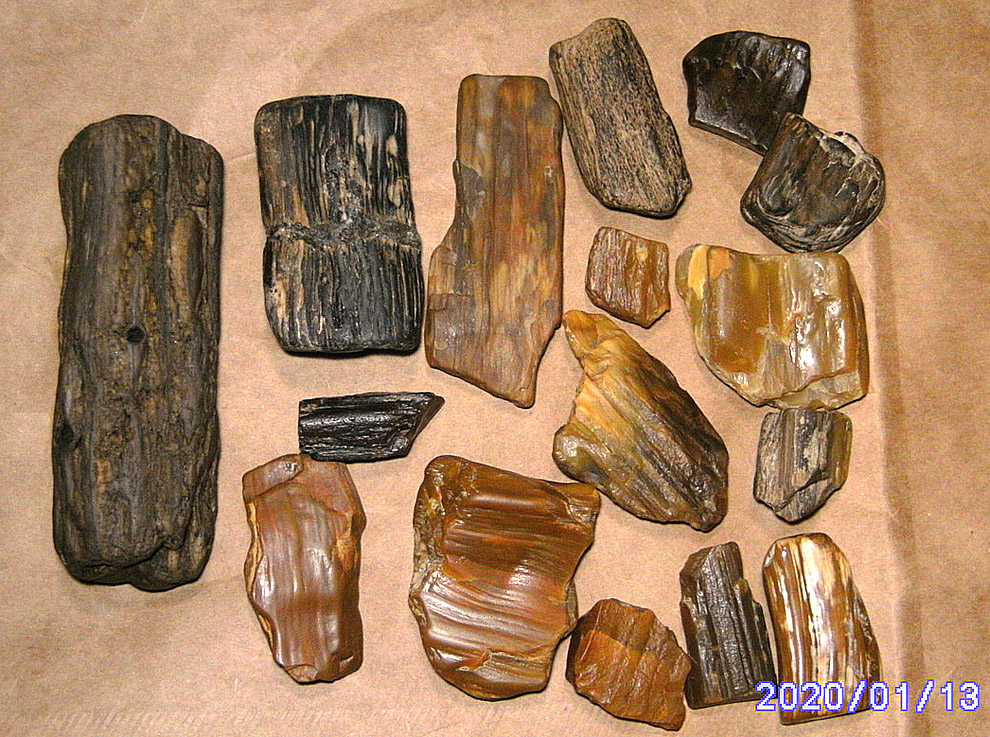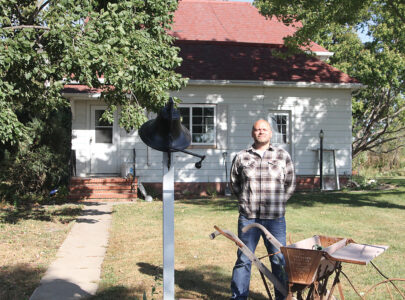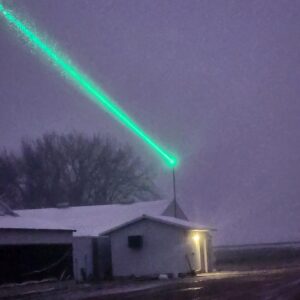Rare fossils turn up along Cottonwood
William Eibner of New Ulm was looking for agates and petrified wood along the Cottonwood River banks last year when he came across Ice Age fossils.

Photos courtesy of William Eibner Looking over bones found near the Cottonwood River last year outside the Riverside History & Nature Center are, from left, Vince Dietz, Ron Bolduan, William Eibner, Science Museum paleontologist Alex Hastings and Marcus Brandel.
- Photos courtesy of William Eibner Looking over bones found near the Cottonwood River last year outside the Riverside History & Nature Center are, from left, Vince Dietz, Ron Bolduan, William Eibner, Science Museum paleontologist Alex Hastings and Marcus Brandel.
- Eibner found many bones including teeth, jaws and ribs on the Cottonwood River in and around New Ulm that were donated to the Science Museum of Minnesota in St. Paul.
- Some of the more colorful pieces of petrified wood Eibner found near the Cottonwood River.
- Mammoth teeth, pictured here, were among the larger, more intact bones found.
“I found more bones than agates,” Eibner said. “Everything was found without digging. Some bones were partially buried. The bones looked like they were from animals that no longer lived here.
“After some time spent researching bison teeth online, I was confident of a match. That’s when I started seeking help from an expert and eventually got into contact with Alex (Hastings).”
Eibner said the first bone he found was a bison molar on a sandbar near Adams Park on Cottonwood Street on the south edge of New Ulm.
Eibner hand-carried two boxes of 51 items to the Science Museum in St. Paul Dec. 14. Items in boxes included a mammoth tooth, pig or bear teeth, a jaw piece, miscellaneous bones, elk joints, baby pig jaw, elk antler bones, vertebrae, dog skulls, fossil horse teeth, a rib, and bird bones, among other bones.

Eibner found many bones including teeth, jaws and ribs on the Cottonwood River in and around New Ulm that were donated to the Science Museum of Minnesota in St. Paul.
Alexander K. Hastings, Ph. D., Fitzpatrick Chair of Paleontology at the Science Museum of Minnesota, said he considered Eibner’s donations quite rare and significant.
“I checked again and still can find no published record of fossil horses in Minnesota,” said Hastings. “There may be some in people’s basements somewhere, but in terms of official records, nada.”
Hastings said Eibner’s finds are “very significant, because very few mammoth fossils from Minnesota have actually made their way into scientific collections.”
“Even fewer have good location information, so knowing exactly where this came from is really good for scientific research,” said Hastings. “Moreover, there haven’t been any mammoths from the area that have been verified in any scientific work or held in a collection. It also really excites me about the opportunities for the future. This shows unquestionably that Ice Age fossils can be found in the Cottonwood. There is every potential for more. Even though the specimen is quite worn, it is still unmistakably mammoth. It’s a great find. I really look forward to what else we can find as we look forward to the spring field season.”
The oldest bones, like those from the mammoth that Eibner found are 11,000 years old or older. Other bones may be just a few years told, Hastings said.

Some of the more colorful pieces of petrified wood Eibner found near the Cottonwood River.
“Once funds can be gathered, carbon dating will give better answers on how old it all is. That will take quite some time,” Hastings said. “The mammoth is most likely a Columbian Mamuthus columbi, although identification is tricky with fragmentary material. These mammoths roamed much of the Great Plains during the last Ice Age.”
Hastings said he plans to return to revisit the Cottonwood River this spring and summer.

Mammoth teeth, pictured here, were among the larger, more intact bones found.








